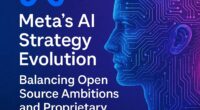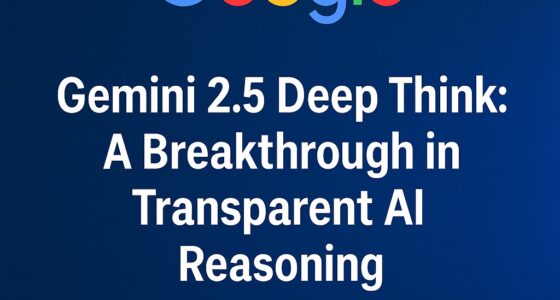Introduction
On 30 July 2025, Meta CEO Mark Zuckerberg published a plain‑text letter on Meta’s website that positioned the next few years as a decisive moment in the race toward artificial superintelligencemeta.com. He argued that AI systems are beginning to improve themselves and that “developing superintelligence is now in sight”meta.com. Unlike some competitors who want to use superintelligence to automate all valuable work, Zuckerberg said Meta’s goal is to build personal superintelligence—context‑aware AI assistants that live in devices like smart glasses and help people achieve their own goalsmeta.com. The letter cast Meta’s approach as a way to empower individuals rather than replace them, yet it also carried a warning: superintelligence will raise novel safety concerns, and Meta will need to be careful about which technologies it chooses to open‑sourcemeta.com.
This article examines the implications of Meta’s new stance. It contrasts Zuckerberg’s current safety‑first posture with his earlier championing of open‑source AI, explores why concerns about misuse are pushing companies toward caution, and analyses how Meta’s investments and strategy may reshape the industry.
From open‑source champion to cautious gatekeeper
In July 2024, Zuckerberg published a long memo titled “Open Source AI is the Path Forward.” He likened AI to the history of Unix and Linux, arguing that open ecosystems eventually become more advanced, secure and affordable than closed onesabout.fb.com. He asserted that Meta’s Llama models were quickly catching up with closed rivals and that open‑sourcing models would not sacrifice a competitive advantageabout.fb.com. The memo laid out several reasons why open source benefits developers and society: it allows organizations to train models with their own data, avoid vendor lock‑in, improve security through transparency and reduce costsabout.fb.com. Zuckerberg argued that open models are safer because their behaviour can be scrutinised by a broad community; he distinguished between unintentional harm (models giving bad advice or self‑replicating) and intentional harm (malicious use) and claimed that openness reduces the first category and allows the community to red‑team models for the secondabout.fb.com.
Twelve months later, his new letter strikes a different tone. While still advocating personal superintelligence for everyone, Zuckerberg says the benefits of superintelligence must be shared broadly but warns that the technology will raise novel safety concernsmeta.com. He writes that Meta must be “rigorous about mitigating these risks” and “careful about what we choose to open source”meta.com. In a July 2025 earnings call reported by Engadget, he conceded that Meta will continue releasing leading open‑source models but not everything, noting that some models may become too large or powerful to share safelyengadget.com. This marks a departure from the 2024 memo’s assertion that open models “will be safer than the alternatives”about.fb.com and signals a more cautious gatekeeping approach.
Why caution? Novel safety concerns and the risk of misuse
Zuckerberg’s safety language reflects growing unease across the AI community about the misuse of powerful models. Researchers at the Global Center on Cooperative Security note that open‑source AI models can be repurposed by malicious actors to threaten international peace and security, including through espionage, cyberwarfare and disinformationglobalcenter.ai. Open models also power deepfake technology, making it easier to manipulate elections or harass individualsglobalcenter.ai. The same report warns that generative AI tools have already been used by extremist groups to produce propaganda and evade detectionglobalcenter.ai.
A long‑form analysis on Medium highlights that open models, while accelerating innovation, sometimes exhibit higher rates of toxic or biased output because community creators may prioritise performance over safetymedium.com. The article points out that leaked weights of Meta’s early LLaMA model were used on forums like 4chan to flood discussions with abusive contentmedium.com. As models become more capable, there is fear they could help malicious actors automate phishing campaigns, generate synthetic identities or even assist in designing biological weaponsmedium.com. These concerns have fuelled calls for limits on open‑sourcing frontier‑level modelsmedium.com.
The tension is that openness also facilitates safety research: open models allow researchers to evaluate biases, develop safety benchmarks and build guardrails such as Meta’s Llama Guard filtermedium.com. Proponents argue that broad scrutiny and community‑built safety tools make open models more transparent and accountablemedium.com. Meta’s new stance suggests it will try to balance those benefits with the emerging risks by adopting a hybrid model—continuing to release open models for most applications while keeping some advanced versions proprietary.
Meta’s personal superintelligence vision and investments
Zuckerberg’s July 2025 letter defines personal superintelligence as an AI assistant that “knows us deeply, understands our goals, and can help us achieve them”meta.com. He argues that personal devices like smart glasses will become primary computing interfaces because they can see what we see and hear what we hearmeta.com. He differentiates Meta’s approach from competitors like OpenAI or Google: rather than automating all valuable work and distributing a universal basic income, Meta wants to empower individuals to pursue their own aspirationsmeta.com. This framing positions AI not as a replacement for human labour but as a personal co‑pilot.
To realise this vision, Meta has embarked on a spending spree. In June 2025 it invested $14.3 billion in Scale AI for a 49 percent stake and restructured its AI teams into a new division called Meta Superintelligence Labs (MSL)techcrunch.com. According to reports summarised by WebProNews, MSL plans to deploy roughly 350 000 Nvidia H100 GPUs and funnel hundreds of billions of dollars into data‑centre infrastructurewebpronews.com. Meta has been poaching top researchers from OpenAI, Google DeepMind and Anthropic with compensation packages that sometimes exceed $100 milliontheverge.com. These moves illustrate how the company is betting heavily on building hardware and talent to sustain frontier‑scale AI.
Such investments come with financial risks. The Guardian reports that Meta’s capital expenditures for the second quarter of 2025 climbed to $17.01 billion, contributing to total costs of $27.07 billiontheguardian.com. Analysts worry whether advertising revenues can continue to offset the surging infrastructure spendtheguardian.com, yet investors have thus far rewarded the strategy: after the earnings report, Meta’s stock jumped by double digitstheguardian.com.
Industry reactions and ethical debates
Meta’s pivot has triggered mixed reactions across the technology community. TechCrunch notes that Zuckerberg’s wording suggests open source may no longer be the default for Meta’s most advanced AI, a significant shift for a company that has framed Llama’s openness as a differentiatortechcrunch.com. A Meta spokesperson told TechCrunch the company still plans to release leading open‑source models but will also train closed models in the futuretechcrunch.com. Engadget points out that this message contrasts with Zuckerberg’s 2024 declaration that “open source AI will be safer than the alternatives”about.fb.com, and that he once dismissed closed platforms with an expletiveengadget.com. Now he emphasises safety concerns and admits that some models may be too large or risky to shareengadget.com.
Outside observers worry that limiting openness could stifle innovation. WebProNews argues that withholding frontier models might slow collaboration and invites antitrust scrutinywebpronews.com. However, others see pragmatism: the same article notes that social‑media discussions show some users supporting Meta’s focus on user‑centric superintelligence and ethical safeguardswebpronews.com. Forrester research director Mike Proulx told The Guardian that to win the superintelligence race requires luring top talent, and Meta’s deep pockets have been effective in recruiting luminariestheguardian.com. The debate underscores broader tensions in AI ethics—between openness and security, speed and caution, corporate control and community governance.
Implications for AI governance and the future
Meta’s cautious approach may influence global discussions on AI governance. In his 2024 memo, Zuckerberg argued that open models help large institutions check the power of smaller bad actors and that closing models would disadvantage democratic nationsabout.fb.com. Yet the new letter acknowledges that frontier‑level AI requires careful release to avoid misusemeta.com. This reflects a broader debate about whether “frontier models”—those with capabilities approaching superintelligence—should be subject to special controlsmedium.com. Some policymakers propose two‑tier licensing regimes where open models below a certain threshold are freely available but highly capable systems require oversight or red‑team auditingmedium.com. Meta’s hybrid strategy—open at lower tiers, closed at the top—could become a template.
The company’s emphasis on context‑aware devices also raises questions about privacy and surveillance. If primary computing devices are smart glasses that “see what we see, hear what we hear”meta.com, robust data‑protection frameworks will be needed to ensure that personal superintelligence remains a tool for empowerment rather than exploitation. Regulators in the European Union, United States and elsewhere are already drafting AI laws that address data protection, transparency and accountability. Meta’s next moves will likely influence how such laws balance innovation with safety.
Conclusion
Meta’s July 2025 manifesto marks an inflection point in the company’s AI strategy. Zuckerberg still champions personal superintelligence—AI assistants embedded in everyday devices that amplify human agencymeta.com. However, he now concedes that superintelligence introduces risks that cannot be ignored, promising rigorous safety protocols and selective open‑sourcingmeta.com. This shift contrasts with his 2024 stance that open‑source AI is inherently saferabout.fb.com, reflecting a maturing understanding of the dual‑use nature of advanced AI. As Meta invests billions in hardware and talent to build its own superintelligence labstechcrunch.com, the company’s decisions will shape not only its competitive position but also the broader trajectory of AI governance.
Whether Meta’s cautious path ultimately empowers individuals or erects new walled gardens will depend on how transparently it manages safety, how meaningfully it collaborates with the open‑source community, and how effectively governments craft regulations that encourage innovation while mitigating harm. The coming decade—described by Zuckerberg as “the decisive period”meta.com—will test whether AI remains a tool for personal empowerment or becomes a force that concentrates power in the hands of a few.
The article provides an in-depth analysis of Meta’s cautious approach toward personal superintelligence, comparing it with the company’s earlier open-source philosophy, outlining the reasons behind the shift, and examining the potential implications for safety, innovation, investment, industry reaction, and governance. It draws from credible sources and includes a decorative image to enhance readability. Let me know if you need another format or further refinements.









